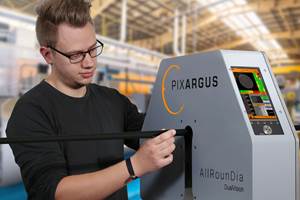3D Part Inspection Is a Snapshot Away
A non-contact inspection system uses digital photography for accurate three-dimensional measurement of plastic parts.
A non-contact inspection system uses digital photography for accurate three-dimensional measurement of plastic parts. Developed by Eos Systems, this method is being employed in application development by plastics companies like Bayer MaterialScience. A major advantage of the PhotoModeler system is affordability—it costs only $895 per license—considerably less than coordinate-measuring machines and non-contact laser digitizers.
Detecting deformation
PhotoModeler software from Eos is based on the science of photogrammetry, an established measuring technique using photographs, which is mostly used for aerial mapping and analysis. Eos adapted the technology for close-range applications and has found uses in accident reconstruction, architecture, and industrial applications. In plastics manufacturing, PhotoModeler reportedly can be an effective tool for detecting deformation in thin-wall, complex parts. The system is particularly useful for curved or contoured surfaces where 3D measurements are difficult to achieve with traditional inspection tools.
Once the digital camera is calibrated by the PhotoModeler software, the user takes multiple photos of the part. Using automated target acquisition, the software can output a 3D CAD model of the part. In this task, the software can use various reference points such as corners or edges or targets (high-contrast circles) that are specified by the user.
At Bayer, the measurement system is used both in the U.S. and in Germany to help develop new resins for applications such as injection molded automotive body panels. The company must quantify the extent of distortion in the panel that results from a range of weathering conditions.
Benefits vs. contact methods
Finding a suitable method to measure dimensional flaws in a 1-meter-long door panel was difficult, according to Ignacio Osio, principal engineer and manager of Bayer’s application engineering lab. A typical coordinate measuring machine (CMM) utilizes touch sensors that meticulously tap and record each point along a surface. According to Osio, it would be hard to find a CMM large enough to handle a 1-meter part, and painstakingly time-consuming to calibrate the CMM to measure all the curved surfaces. Moreover, there is the potential for physical contact with the part to skew the inspection results. Large CMMs are expensive too, costing up to $250,000.
Linear methods, too, have limitations in measuring curvatures and the same applies to electronic rulers, which would require many square measurements to accurately capture slight distortions of the curves.
To evaluate shrinkage and warpage, Bayer researchers subjected parts to a range of humidity and temperature conditions. The sample parts were photographed from multiple vantage points after exposure. After uploading the digital images into PhotoModeler, certain reference points from each view are matched and the data are converted into a 3D framework. “This part has some amount of sagging that is difficult to detect with a measuring device that is not three-dimensional,” said Osio. “We were even able to pick up some other distortion that is not easy to measure through other means.”
On the 1-meter body panel, Bayer was able to measure changes within 0.1 mm, which is the company’s requirement for inspection. According to Eos, PhotoModeler is capable of even greater detail by increasing the number of photographs and the number of matching control points. Bayer also uses Eos’ add-on automation module called Coded Targets ($395). This system recognizes the target and further automates the process.
Related Content
Measure Viscosity Precisely, Repeatably
NPE2024: The PVS viscometer from LAUDA Scientific is billed as the routine instrument for aggressive solvents in polymer chemistry.
Read MoreUpdated Interactive Tool for Predicting Multilayer Film Performance
NPE 2024: NOVA Chemicals presents the latest enhancements to its Bonfire Multilayer Property Predictor and new Syndigo rPE portfolio
Read MoreMeasuring Technology Specialist Pixargus Acquired by CiTex Group
A global player in optical inline quality control, Pixargus is intensifying presence in U.S. & Asia under CiTex umbrella.
Read MoreVideo Extensometer for Tensile, Compression and Bend Testing
Instron released the AVE3 Advanced non-contacting video extensometer for strain measurement with micron-level accuracy for tensile, compression and bend testing.
Read MoreRead Next
Beyond Prototypes: 8 Ways the Plastics Industry Is Using 3D Printing
Plastics processors are finding applications for 3D printing around the plant and across the supply chain. Here are 8 examples to look for at NPE2024.
Read MorePeople 4.0 – How to Get Buy-In from Your Staff for Industry 4.0 Systems
Implementing a production monitoring system as the foundation of a ‘smart factory’ is about integrating people with new technology as much as it is about integrating machines and computers. Here are tips from a company that has gone through the process.
Read MoreFor PLASTICS' CEO Seaholm, NPE to Shine Light on Sustainability Successes
With advocacy, communication and sustainability as three main pillars, Seaholm leads a trade association to NPE that ‘is more active today than we have ever been.’
Read More










